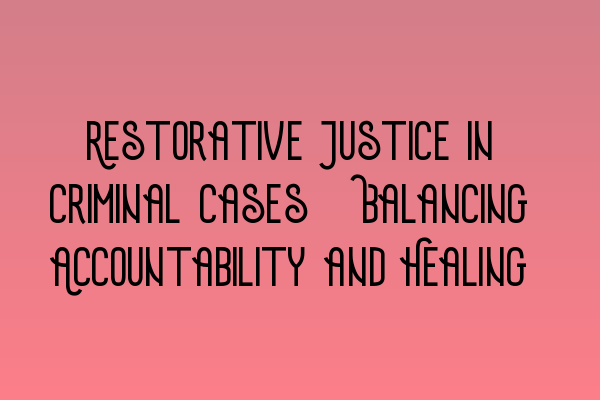Restorative Justice in Criminal Cases: Balancing Accountability and Healing
Restorative justice is an approach to criminal cases that focuses not only on holding offenders accountable for their actions but also on facilitating healing and reconciliation between the offender and the victim. It seeks to address the harm caused by the crime and restore the affected parties, while also aiming to prevent future offenses.
At SQE Criminal Law & Practice Law UK, we believe that restorative justice has the potential to transform the criminal justice system. In this blog post, we will delve into the concept of restorative justice, its benefits, and how it can be effectively implemented in criminal cases.
Understanding Restorative Justice
Restorative justice is based on the belief that crime causes harm to individuals and communities, and it is essential to address this harm in a meaningful way. It shifts the focus from punishment to repairing the harm and building relationships. Rather than solely relying on legal processes, restorative justice encourages active participation from all involved parties, including the victim, the offender, and the community.
Restorative justice emphasizes communication, dialogue, and the acknowledgment of responsibility. It provides an opportunity for victims to express the impact of the crime on their lives and feel heard, while offenders are given a chance to understand the consequences of their actions and take steps towards making amends.
The Benefits of Restorative Justice
Restorative justice offers numerous benefits over traditional punitive approaches in criminal cases. Some of these advantages include:
- Empowering Victims: Restorative justice provides victims with a voice and an active role in the process. It allows them to express their emotions, ask questions, and receive answers from the offender directly. This empowerment and involvement in decision-making can contribute to their healing process.
- Accountability: Restorative justice holds offenders accountable for their actions in a more meaningful way than incarceration alone. It encourages them to understand the impact of their behavior and take responsibility for their actions. By actively participating in the process, offenders gain insight into the harm they have caused and work towards making amends.
- Reducing Recidivism: Studies have shown that restorative justice programs can lead to lower rates of recidivism. By addressing the root causes of criminal behavior and promoting rehabilitation, restorative justice aims to break the cycle of crime and prevent future offenses.
- Community Building: Restorative justice involves the community in the process, allowing them to play a role in repairing the harm caused by the crime. This active involvement fosters stronger community bonds and promotes a sense of collective responsibility for preventing and addressing crime.
Implementing Restorative Justice in Criminal Cases
While the benefits of restorative justice are evident, effective implementation requires careful planning and resources. Here are some key steps that should be taken to ensure the successful integration of restorative justice in criminal cases:
- Educating Criminal Justice Professionals: It is crucial to provide training and education to judges, prosecutors, defense attorneys, and other criminal justice professionals about restorative justice principles and practices. This will help them understand its value and ensure its consistent application.
- Establishing Supportive Policies and Legislation: Governments and legal institutions should create policies and legislation that support the implementation of restorative justice. This includes providing funding, establishing clear guidelines, and promoting collaboration between different agencies and stakeholders.
- Building Partnerships: Collaboration between criminal justice agencies, community organizations, and victim support services is essential. By working together, these stakeholders can ensure the effective delivery of restorative justice programs and services.
- Ensuring Accessibility: Restorative justice should be accessible to all parties involved, regardless of socioeconomic status or background. Measures should be taken to provide support and resources, such as interpreters, transportation, and counseling, to enable meaningful participation.
Conclusion
Restorative justice offers a more holistic and inclusive approach to criminal cases, balancing accountability and healing. It fosters empathy, understanding, and communication between the victim, the offender, and the community. By focusing on repair and rehabilitation, it has the potential to transform the criminal justice system, reduce recidivism rates, and build stronger, safer communities.
If you’re interested in learning more about criminal law and the SQE exams, check out these related articles:
